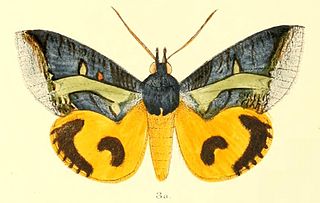
Psilogramma menephron, the privet hawk moth or large brown hawkmoth, is a member of the family Sphingidae. It was described by Pieter Cramer in 1780. It is usually found in Sri Lanka, India, Nepal, central and southern China, Thailand, Vietnam, Indonesia and the Philippines. Psilogramma casuarinae from eastern Australia was long treated as a synonym but is now thought to be a distinct species. The introduced population on Hawaii was first thought to be P. menephron, but is Psilogramma increta.

The lobster moth, also known as lobster prominent, is a moth from the family Notodontidae. The species was first described by Carl Linnaeus in his 10th edition of Systema Naturae. The English name refers to the crustacean-like appearance of the caterpillar.

Achaea janata, the castor semi-looper or croton caterpillar, is an erebid moth, the caterpillars of which are termed 'semi-loopers' due to their mode of locomotion. It is found from the Indo-Australian tropics and subtropics, extending south to New Zealand and east through the Pacific archipelagoes to Easter Island. It is a major pest of castor throughout the world.

Hulodes caranea is a species of moth of the family Erebidae first described by Pieter Cramer in 1780. It is found from India, Sri Lanka, Myanmar, Java, Hong Kong to Queensland and New Guinea, it is also found on the Marianas and Carolines.

Thyas coronata is a species of moth of the family Erebidae first described by Johan Christian Fabricius in 1775. It is found from the Indo-Australian tropics of southern China, Taiwan, Japan, Nepal, India, Sri Lanka to Micronesia and the Society Islands.

Eudocima phalonia, the common fruit-piercing moth, is a fruit piercing moth of the family Erebidae. The species was first described by Carl Linnaeus in his 1763 Centuria Insectorum. It is found in large parts of the tropics, mainly in Asia, Africa and Australia but introduced into other areas such as Hawaii, New Zealand and the Society Islands. It is one of major fruit pests in the world.

Eudocima homaena is a moth of the family Erebidae first described by Jacob Hübner in 1816. It is found in the Indian subregion, Sri Lanka, Myanmar, Taiwan, the Nicobars, Peninsular Malaysia, Borneo, the Philippines and on Christmas Island. It is a major pest on orange plants.

Eudocima salaminia, the green fruit-piercing moth, is a moth of the family Erebidae. The species was first described by Pieter Cramer in 1777. It is found from India, and across south-east Asia to the Pacific Islands. In Australia it occurs in the Northern Territory, Queensland and New South Wales. The adult is a fruit piercer.

Pergesa is a monotypic moth genus in the family Sphingidae first described by Francis Walker in 1856. Its only species, Pergesa acteus, the green pergesa hawkmoth, was described by Pieter Cramer in 1779.

Chadisra bipars is a moth of the family Notodontidae. It was described by Francis Walker in 1862 and is found in the Indomalayan realm.

Trabala vishnou, the rose-myrtle lappet moth, is a moth of the family Lasiocampidae. It is found in southern Asia, including Pakistan, India, Bangladesh, Thailand, Sri Lanka, Myanmar, Java, China, Japan, Taiwan, Hong Kong, Vietnam and Indonesia. Four subspecies are recognized.

Calyptra minuticornis, the vampire moth, is a moth of the family Erebidae. It has been found in Indonesia, Java, India, Sri Lanka, and Australasia.

Tiracola plagiata, the cacao armyworm, is a moth of the family Noctuidae. The species was first described by Francis Walker in 1857. It is found from south-east Asia, South India, Sri Lanka, Myanmar to the South Pacific Islands, including the northern two-thirds of Australia.

Orgyia postica, the cocoa tussock moth or hevea tussock moth, is a species of moth of the subfamily Lymantriinae of the family Erebidae found in the Oriental tropics of India, Sri Lanka, Myanmar, Borneo, Java, New Guinea, and Taiwan. It was described by Francis Walker in 1855.

Stauropus is a genus of moths of the family Notodontidae first described by Ernst Friedrich Germar in 1812.

Arctornis submarginata is a species of moth of the subfamily Lymantriinae of family Erebidae. It is found in the north-eastern Himalaya and Sikkim, Sri Lanka, on Borneo and Sumatra and in northern Australia.

Somena scintillans, the yellow tail tussock moth, is a moth in the family Erebidae described by Francis Walker in 1856. It is found in northern India, Sri Lanka, Myanmar and the Andaman Islands. Though considered a minor pest, larva can sporadically be a serious pest.

Aloa lactinea, the red costate tiger moth, is a moth of family Erebidae. The species was first described by Pieter Cramer in 1777. It is found in India, Japan, southern and western China, Taiwan, Java, Sumatra, Sri Lanka, Myanmar and the Philippines.

Autoba abrupta is a species of moth of the family Erebidae. It is found in Papua New Guinea, Thailand, and Australia. The species is largely used by the name Eublemma abrupta in Indian and Sri Lankan texts.

Polytela gloriosae, the Indian lily moth or lily caterpillar, is a moth of the family Noctuidae. The species was first described by Johan Christian Fabricius in 1781. It is found in Sri Lanka, India and probably in Indonesia.



















